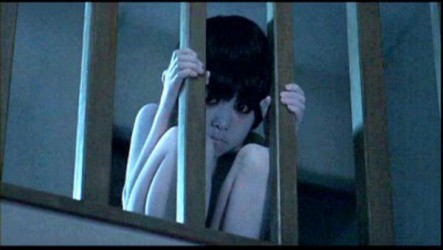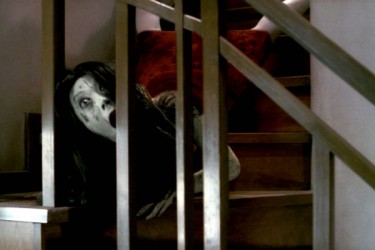Rated R, 92 minutes
Fair Value of Ju-On: $30.00. Along with Ringu, Pulse, and Dark Water, Ju-On is a definitive pillar of the ‘J Horror’ genre. It’s a brilliant re-invention of old tropes, using the trappings of the haunted house film to build to something bleaker, more terrifying in complete nihilism than basic bumps in the night.
TL, DR: Leaving the haunted house will not save you.
Vignettes of Inevitable Doom: It’s a somewhat old but conventional suburban dwelling, apparently post-war. No baroque embellishments, no towers or grandfather clocks, just an extremely mundane, urban lower middle class domicile. The banality of the setting serves to make the extremity of the horrors within all the more breathtaking. We get a hint of the initial atrocity; a man murdering his wife. From there the film follows the fates of those who visit or inhabit the dwelling. The first victim is a hapless social welfare intern, sent to provide assistance to the elderly woman dwelling there. Then we go to the new residents; then police investigators; then ghost hunters. All who step across the threshold of the front yard perish under the gaze of ghosts. By operating within this vignette structure, we get a sense of how the legend of the house grows. But more importantly, it allows the film-maker to riff on the ghost story, telling a little more of the story with each victim, each of which last slightly longer than the last.
Relentless: What really makes this movie original is that, along with Pulse, it posits the notion of a ghost apocalypse. Instead of an ever-growing tide of infectious cadavers, Ju-On suggest a merciless campaign of ghosts, destroying humanity one person at a time, depopulating blocks, then neighborhoods, then cities. The malignancy at the heart of this is eventually explained, but understanding the motives of the specters does nothing to counter or slow them. The most powerful conceptual terror of the film gives the title, which is mis-translated into English as the grudge. Grudge connotes a trivial animosity, not the depths of hostility that propels the malignancy of this film A better synonym would be The Vendetta, or The Scourge. This is a film about Absolute Hate, a hate so strong and so pure that it spirals ever outward, unfulfilled, all-devouring. The idea of pure human misanthropy being given infinite power- the only constraint being a pure spiteful sadism that insists on tormenting and toying with each individual before dispatching them.

American reaction: OMG How cute!
Japanese Ghost Tropes: Cats are frequently avatars of evil in Japanese folklore (Bakoneko). This is one of the few motifs that doesn’t translate universally, but it still has some effective moments. Another cultural convention that doesn’t come across the Pacific is the emphasis on family shrines- they’re a major and universal reminder of death in Japanese culture, but the dead of the West are lucky to get more than a few moldering photo albums. A more frightening conventional trope is having hair-shrouded feminine ghosts. Her face obscured in matted black hair until a critical moment. And then eyes open, bright and wide within a field of night.
Fear the Foley Man: The difference between the risible and the eldritch can be a matter of the queuing of the sound effects. Ju-On is masterfully edited for sound. Raspy breaths, faint scrabbles behind the walls, sometimes used to crescendo, either times used for a ‘cat scare’. Most of all, the signature sound of the ghosts- this film will teach you what a death rattle sounds like.
Time and Vision: Other than exploring the concept of infinite hatred, the other abstract them of Ju-on is the role of vision and perception. The ghosts are foreshadowed by perceptual glitches- the TV screen bends and blurs, the cell phone conversation gives way to another unearthly croak. Viewing the ghosts paralyzes people, and yet at the same time, the ghost appear to be unable to act upon a person who has not yet seen them.
The Antagonist: In the West, we tend to think of ghosts as being either bodiless persons, or else a human-like pattern of powerful emotions and memories- a form of PTSD that carries life past the victim’s existence. Thus, it is more disturbing to see the ghosts in this film, as they are only the most fragmentary vestiges of personhood. The outline is humanoid; but the movement and the sound is insectile. These beings don’t move with the articulation of human beings; the effect is a face-first plunge into the extremes of the uncanny valley.
How Terrible is it all, really? It’s one of the major classics of modern Japanese horror cinema, and deservedly so. There are some timeless shots- the elevator shot, where the ghost tracks on every floor, for instance. Then there’s the security camera sequence, which speaks the secret unease of every viewer: that the subject of the camera eye shall somehow notice the viewer, and then, transport themselves through the camera. I’d liken this film to The Shining, or to Poltergeist– it takes a lot of old cliches, the sort of thing that was richly parodied in Hausu, and figures out how to make them scary again.
Lessons on How Not to Die: Like a lot of the best horror films, Ju-On works by suggesting just enough of a logic for the audience to think there’s a system. We are conditioned by the tropes of horror cinema to believe that there’s a Last Girl, that a mercy will be granted to either the smart or the moral or the lucky. But true cosmic horror, a genuine sense of doom, is hard to convey. Usually, a completely nihilistic horror movie comes on too strong, making the rest of the film seem either unfair or just inevitable. To manage cosmic horror, a film needs to dangle a fragile gossamer of hope to the viewer. Ju-On is one of the few films that achieves this illusion of survival with the proper balance. It is this revelation which makes the ending shots of the film so powerful. Ju-on is in my personal top 20 for films that have deeply frightened me.

